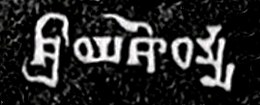Yashodharman
| Yashodharman | |
|---|---|
Aulikara ruler of Malwa | |
| Reign | 515–545 AD |
| Religion | Hinduism |





 Śrī Yaśodharmma ("Lord Yashodharman") in Gupta script in Line 4 of the Mandsaur stone inscription of Yashodharman-Vishnuvardhana.[1]
Śrī Yaśodharmma ("Lord Yashodharman") in Gupta script in Line 4 of the Mandsaur stone inscription of Yashodharman-Vishnuvardhana.[1]Yashodharman (
History
Towards the end of the 5th century, India came under attack from the
Three inscriptions of Yasodharman have been found in Mandsaur. One of these, the Mandsaur stone inscription of Yashodharman-Vishnuvardhana is of samvat 589 (532 AD).
Mandsaur stone inscription of Yashodharman-Vishnuvardhana (532 AD)
The Mandsaur stone inscription of Yashodharman-Vishnuvardhana was written in 532 AD, and records the construction of a well by a person named Daksha in Dashapura (modern
"(L. 5.)— And, again, victorious over the earth is this same king of men, the glorious Vishnuvardhana, the conqueror in war; by whom his own famous lineage, which has the
Aulikara-crest, has been brought to a state of dignity that is ever higher and higher. By him, having brought into subjection, with peaceful overtures and by war, the mighty kings of the east and many (kings) of the north, this second name of "Supreme King of Kings and Supreme Lord", pleasing in the world (but) difficult of attainment, is carried on high."— Mandsaur stone inscription of Yashodharman and Vishnuvardhana[8]
Mandsaur pillar inscription of Yashodharman (515–550 AD)

Twin monolithic pillars at
"He (Yasodharman) to whose two feet respect was paid, with complimentary presents of the flowers from the lock of hair on the top of (his) head, by even that (famous) king
Mandsaur pillar inscription of Yashodharman[14]
Territory
In Line 5 of the Mandsaur pillar inscription, Yashodharman claims he vanquished his enemies and now controls the territory from the neighbourhood of the (river) Lauhitya (Brahmaputra River) to the "Western Ocean" (Western Indian Ocean), and from the Himalayas to mountain Mahendra.[10][3]
Yashodharman thus conquered vast territories from the Hunas and the Guptas,[15] although his short-lived empire would ultimately disintegrate between c. 530–540 AD.[3]
References
- ^ a b Fleet, John Faithfull (1960). Inscriptions Of The Early Gupta Kings And Their Successors. pp. 150–158.
- ISBN 978-81-7099-552-4.
- ^ a b c Foreign Influence on Ancient India by Krishna Chandra Sagar p.216
- ISBN 9788120815407.
- ^ Hans Bakker50 years that changed India (Timeline)
- ^ Historical Geography of Madhyapradesh from Early Records by P. K. Bhattacharyya p.200
- ^ a b Indian Esoteric Buddhism: Social History of the Tantric Movement by Ronald M. Davidson p.31
- ^ Fleet, John F. Corpus Inscriptionum Indicarum: Inscriptions of the Early Guptas. Vol. III. Calcutta: Government of India, Central Publications Branch, 1888, 150sq.
- JSTOR 24654606.
- ^ a b Corpus Inscriptionum Indicarum Vol 3 p.145
- ^ Fleet, John F. Corpus Inscriptionum Indicarum: Inscriptions of the Early Guptas. Vol. III. Calcutta: Government of India, Central Publications Branch, 1888, 147–148
- ^ Mandasor Pillar Inscription of Yashodharman
- ^ Coin Cabinet of the Kunsthistorisches Museum Vienna
- ^ Punjab Monitor, April 2013 [1], from Fleet, John F. Corpus Inscriptionum Indicarum: Inscriptions of the Early Guptas. Vol. III. Calcutta: Government of India, Central Publications Branch, 1888, 147–148.
- ^ Tribal Culture, Faith, History And Literature, Narayan Singh Rao, Mittal Publications, 2006 p.18
